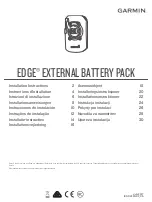
need to be replaced. If the voltage is higher than
12V, try to charge the battery again.
앬
If the charger indicates nothing and the battery is
not charged, check if the charger is connected to
the mains voltage. Pull the mains plug and check
the battery connections.
앬
Charge the battery only at temperatures over
0°C.
앬
Charge boat batteries only outside of the boat.
Figure 3:
Release or remove the battery stoppers (if fitted)
from the battery.
Figure 4:
Check the acid level in the battery. If necessary, top
up the battery with distilled water (if possible).
Important.
Battery acid is aggressive. Rinse off any
acid splashes thoroughly with lots of water and seek
medical advice if necessary.
Figure 5:
First connect the red charging cable to the positive
pole of the battery.
Figure 6:
Then connect the black charging cable to the
bodywork of the vehicle away from the battery and
the petrol pipe.
Figure 7:
After the battery has been connected to the charger,
you can connect the charger to a socket supplying
220-240V~50Hz. Do not connect it to a socket that
supplies any other mains voltage.
Important.
Charging may create dangerous
explosive gas and therefore you should avoid spark
formation and naked flames whilst the battery is
charging. There is a risk of explosion!
Calculating the charging time
The charging time depends on the charge status of
the battery. If the battery is fully discharged, the
approximate charging time can be calculated using
the following formula:
Battery capacity in Ah
Charging time/h
=
Amp. (arithmetic charging current)
24 Ah
Example
=
= 9,6 h max.
2,5 A
Figure 8:
A high charge can only be identified by measuring
the acid density using an acid tester. Note! Gases
are released during the charging process (bubbles
will form on the surface of the battery fluid). It is
essential that you ventilate the rooms well.
Acid density values (kg/l at 20°C)
1.28 Battery
charged
1.21 Battery
semi-charged
1.16 Battery
discharged
Charging:
Perform the settings as shown in Figure 2, in
accordance with the battery you wish to charge.
Quick charge:
If the motor does not start due to lack of battery
voltage, in most cases it is sufficient if the battery is
charged at the highest charge setting (12 A) for
approximately 15 minutes prior to starting.
1. Charge the batter with 12A for 15 minutes
2. Remove the battery.
3. Start the engine. If the attempt to start the engine
fails, charge the battery for a further 15 minutes.
Notes:
Never start an engine without the battery connected.
Never start an engine with the charger connected.
Figure 9:
Pull the plug out of the socket.
Figure 10:
First disconnect the black charging cable from the
bodywork.
Figure 11:
Then release the red charging cable from the
positive pole on the battery.
Figure 12:
Screw or push the battery stoppers back into position
(if there are any).
6. Terminal jack 12V DC
The charger is equipped with a 12V DC terminal jack
at the back of the equipment. The terminal jack
supplies a maximal current of 12A.
To switch on the terminal jack, proceed as follows:
1.
Connect a 12V DC consumer (max. 140 W
power rating) to the terminal jack using a suitable
link cable with a 12V plug (cigarette lighter).
14
GB
Anleitung BT_BC_12_D_SE_SPK1:_ 18.02.2009 7:22 Uhr Seite 14















































